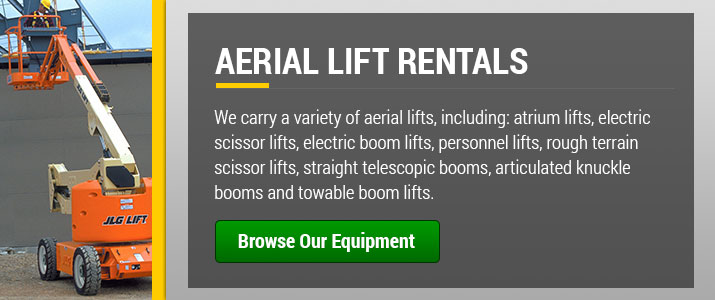There are several deaths and serious injuries each year that come as a result of neglecting aerial lift operator safety, many of which are preventable. In this post, we will give you tips on scissor lift safety procedures and boom lift safety. We will also give you a brief explanation and some background to help you understand why it’s important. We hope that these tips will help guide you, as an employer or an employee, to practice and educate others on aerial lift operator safety.
Jump to Section:
- General Aerial Lift Safety Tips
- Scissor Lift Safety Tips
- Boom Lift Safety Tips
- Man Lift Safety Tips
- Atrium Lift Safety Tips
- Aerial Lift Rentals
General Aerial Lift Safety Tips
Before you decide to buy or rent a lift, you’ll want to consider the safety of both you and your workers. Using aerial lifts incorrectly results in many injuries and deaths every year. To minimize the risk of injury, you and your operators must be educated and trained on the common hazards of construction equipment, appropriate safety procedures, and how to respond in the event of an emergency.
Ensure all necessary safety information is covered in your equipment training courses, including:
- How to clean or deal with hazardous materials and situations. When an employee notices a safety concern, it makes the correction process more efficient if they immediately know what to do to remedy the situation. Faster action makes cleanup more efficient and keeps everyone safer.
- How to inspect jobsites and equipment for potential risks. Spotting safety hazards before beginning work can drastically reduce safety incidents and downtime. All employees should be trained on what safety concerns to look for before they arrive at the jobsite.
- How to avoid common dangers in the work area. It is vital to keep your employees safe by educating them about potential safety risks in their work environment.
- Proper loading and unloading of hardware. The size and complexity of aerial lifts can make even setting up the equipment dangerous for inexperienced workers. All jobsite employees should be trained on best practices of unloading lifts to begin work and loading them back for transportation.
If it’s been an extended period since you or one of your operators has used the equipment in question or if there has been a recent injury or accident in the workplace, retraining might be required. You can never be too cautious in ensuring the safety of your employees. An investment in safety training is not only an investment in the well-being of your workers, but also an investment in your business productivity and job efficiency.
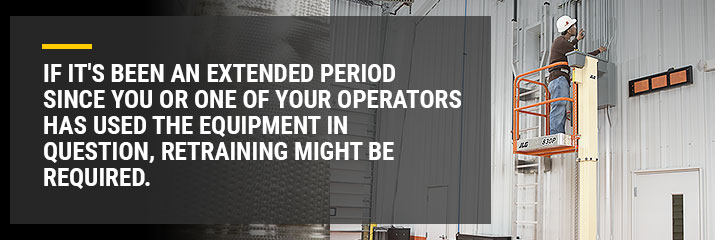
But before we get into specifics, there are some general aerial lift safety precautions that can be taken regardless of what type of aerial lift you’re using. According to investigations of aerial lift safety conducted by The Occupational Safety and Health Administration (OSHA), the main causes of aerial lift deaths are falls, electrocutions and collapses or tip overs. Many of these deaths could have been prevented by following the aerial lift safety procedures that are included in the owner’s manual.
Hire, train and test aerial lift operators.
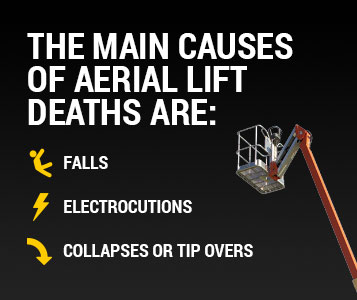
Overall, employers need to make sure aerial lift operators are trained to follow safety procedures. In order to verify the person operating the aerial lift is trained and familiar with the safety procedures, we recommend having employees demonstrate their knowledge before going in the field to operate the piece of equipment. This way the employer can be confident knowing that the employee is well versed in the operation of the equipment and any necessary safety measures. The reason we note this tip first is that if you have a trained person using the lift, they should be familiar with the overwhelming majority of the tips on this list. However, whether you are the employer or the employee, it is good to be familiar with the aerial lift operator safety tips to ensure your aerial lift is being used safely.
Keep a clear mind and focus completely on operating the aerial lift.
Do not use aerial lifts (or any construction equipment) under the influence of drugs or alcohol. Accidents happen without these influences, so adding either of these to the mix increases risk for the operator and co-workers.
In addition to drugs and alcohol, just fooling around and practical jokes can put you and co-workers at risk. Keep it out of the work zone altogether. Make sure you are giving your full attention and focus to operating the aerial lift and following all safety precautions.
Always wear protective equipment.
This aerial lift safety rule is a common one for all pieces of equipment — make sure you have your hard hat, safety glasses and steel-toe boots ready to go. If there is any sort of accident, these types of safety equipment can help minimize your injuries. In addition to wearing your protective equipment, make sure you are not wearing loose clothing that could get caught in any part of the lift (we recommend pulling back long hair, too).
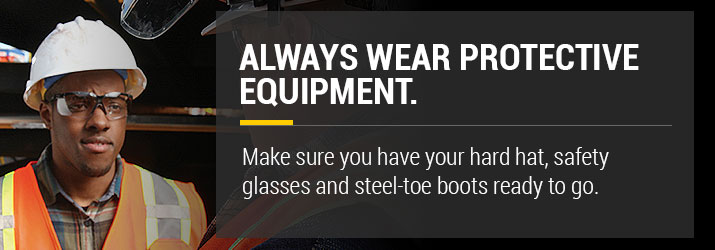
Inspect the aerial lift prior to use.
The aerial lift should be inspected prior to use. Regardless of what type you are using, there are a variety of cords, pulleys, cables and chains that work together to make the lift work. They should be visually inspected to make sure that nothing is loose or out of place. Tires, wheels and casters should also be visually inspected — a solid foundation is essential to safely moving aerial lifts, so it is important that the tires and wheels are in good shape. The lift controls should be tested on site before anyone gets on the platform or in the bucket to ensure everything is working properly. If something seems to be malfunctioning or damaged, the aerial lift should not be used.
Follow capacity limits.
The manufacturer’s capacity limits should be strictly followed. This may seem like a no-brainer, but in addition to the weight of people, it includes all of the tools and bucket liners, too. Calculating the weight can take extra time, especially if additional tools are taken at the last minute. Regardless, the time it takes to calculate and make sure you are within the allowed capacity is worth it, given that one or more people will be relying on the lift to hold them. Make sure all debris is cleared off of the platform and out of the bucket, too – not only does that help free up some space, but it also helps ensure there isn’t anything extra to cause you to slip or trip as you’re working.

Don’t put scaffolding on the aerial lift platform.
In addition to following the capacity limits for the aerial lift, you should also make sure you aren’t using the platform or bucket of the aerial lift as a support system for another piece of scaffolding. Regardless of whether or not it falls within the capacity limit, adding scaffolding or even something as small as a stepping stool, is putting you at a great risk of falling. Your feet should be flat on the platform or bucket at all times (ideally with some anti-slip treads).
Keep your distance from power lines and wires.
The mention of electrocutions within the top three most frequent causes of injury or death with aerial lift may surprise you. But at the heights that aerial lifts are often used there is a good chance you will be level with power lines at some point. Power lines, wires and other conductors should be treated as if they are live wires, even if they appear insulated or you know they are down. To be safe, keep a distance of at least ten feet or three meters between you and any power lines at all times.
Don’t override the safety features.
Almost all aerial lifts come with some sort of safety features built in, whether they are hydraulic, mechanical or electrical. Overriding these safety features is not recommended under any circumstances. These features were put in place by the manufacturer for your safety and should not be overridden.

Beware of using an aerial lift in an area with poor ventilation.
Finally, we want to mention that aerial lifts can create sparks that could ignite any flammable substance — including vapors, fibers and dusts that may be in the atmosphere. Usually a leak or spill of a flammable liquid would be reason to cease work on site, however, while uncommon, these flammable vapors, fibers and dusts could be an issue if you are using an aerial lift in an area with poor ventilation. It is something every aerial lift operator should be aware of; even if it is something they never have to deal with.
In addition to all of these general aerial lift operator safety measures, there are additional safety measures that should be taken for the specific type of lift you’re working with. Scissor lifts and boom lifts work differently, and while they share some safety precautions, they also have some of their own.
Scissor Lift Safety Tips
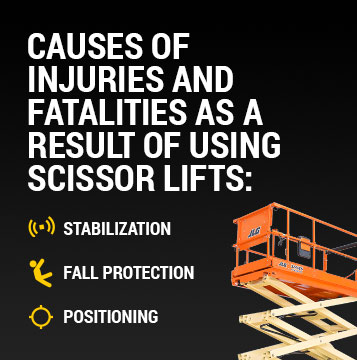 Scissor lifts have a platform that moves straight up and down. Around the work platform, there is a mid rail and a top rail to protect workers from falling off the platform. When these lifts are extended and stationary, they can serve a purpose similar to scaffolding, and, therefore, have many of the same risks. However, the fact that the scissor lifts have the ability to move gives them a set of risks that scaffolding does not have. The Occupational Safety and Health Administration (OSHA) have investigated injuries and fatalities as a result of using scissor lifts and found that the majority of them came down to preventable issues, such as stabilization, fall protection and positioning.
Scissor lifts have a platform that moves straight up and down. Around the work platform, there is a mid rail and a top rail to protect workers from falling off the platform. When these lifts are extended and stationary, they can serve a purpose similar to scaffolding, and, therefore, have many of the same risks. However, the fact that the scissor lifts have the ability to move gives them a set of risks that scaffolding does not have. The Occupational Safety and Health Administration (OSHA) have investigated injuries and fatalities as a result of using scissor lifts and found that the majority of them came down to preventable issues, such as stabilization, fall protection and positioning.
Keep it on firm, level ground.
When scissor lifts are elevated, they are very tall and narrow, making them susceptible to tipping over if they are not stabilized and/or moved properly. The first step to preventing the lift from tipping over is to ensure it is on firm, stable, level ground. The base needs to have a strong, even foundation to support the lift when it is elevated. If you don’t have the most level ground to work with, make sure you’re using brakes and wheel chocks, as necessary — especially on an incline.
Avoid windy weather.
The second step is to make sure you’re only operating a scissor lift outside in weather conditions it can handle. Since it is very tall and slender in an elevated position, you want to avoid using it in windy conditions. It may seem like it would take a lot to push a scissor lift over, but the reality is a good gust of wind can do it. Not sure what the limit is? Don’t worry, the user’s manual will give you a limit, but it’s usually a maximum of 28 miles per hour.

Put distance between the scissor lift and other equipment.
Wind isn’t the only thing that can have enough force to tip a scissor lift over, which brings us to our third step — make sure the scissor lift is out of the way of other equipment. If you are working in tight quarters, this may mean alternating activity with other construction equipment and workers. This can be an inconvenience, especially when you are on a tight schedule, but it’s worth it to avoid the risk of equipment bumping into a scissor lift, causing it to tip over.
Do not move the scissor lift in an upright position.
The final precautionary step you can take to prevent your scissor lift from tipping over is to avoid moving while operating a scissor lift in an upright position — no matter how small the distance. Some models may permit a certain level of movement with it in a partially elevated position, but never make any assumptions. Always make sure you consult the manufacturer’s owner manual so you aren’t putting anyone in danger.

Beware of collapsing.
While it is rare, it’s worth noting that scissor lifts can be unstable in another way: It’s possible that they can collapse. There are safety features built into these aerial lifts to ensure this doesn’t happen, and those features should be tested and maintained as needed — never bypassed. Why would you bypass a safety feature? Sometimes bypassing a safety feature could give you the ability to move the piece of equipment more quickly and conveniently. While there may be temporary benefits, the risks involved are not worth it.
Do not climb or sit on railings.
In addition to the risks of tipping over and collapsing, there is also a risk of falling from the work platform when it is elevated. The mid and top rails are meant to protect workers from falling, but they are not meant to be climbed on or sat upon. The first step in preventing falls from scissor lifts is to make sure these rails are securely in place.
Is anything loose? Is everything on the platform securely fastened? Regardless of how recently the equipment was used, make sure you do your own inspection to minimize risks and ensure the safe use of scissor lifts.
The second step is to ensure the mid and top rails are only being used as a boundary and nothing else. While the scissor lift does a good job of getting workers to the height they need, the width of the platform limits how much horizontal space you can cover. Rather than taking the time to lower the scissor lift and move the entire lift a few feet, it may be tempting to climb on the rails to attempt to reach the area. This can lead to workers falling from the work platform, resulting in serious injury and sometimes death.
Position the scissor lift properly and map out any movement across the site.
The positioning of the scissor lift while on a job site is also important to take into consideration to maximize the safety of employees. Make sure traffic controls are in place to avoid any vehicle or other equipment coming in contact with the scissor lift, especially when it’s in an elevated position. If you must move the scissor lift while it’s in an elevated position, map out the route you’re taking across the job site, no matter how short the distance, to ensure you will avoid electrical lines and any other objects that may be in your way.
Electric Scissor Lift Safety Inspection Checklist
Be sure to follow a thorough process of inspecting your scissor lift before use:
- Assess the condition of the scissor lift at the beginning of each workday. Look for any visible damage, signs of wear or rust.
- Inspect the guardrail around the platform. Make sure the guardrail gate and safety chain are always in place during operation. Keep in mind that the guardrail and the extension arms of the scissor lift are dangerous pinch points. Take care to keep body parts, clothing and other items away from these areas.
- Ensure operator knowledge of controls and safety procedures before usage. Go over emergency response procedures beforehand. If necessary, offer safety training either through a company-sponsored training session or a local college.
- During use, make sure to watch for overhead hazards and obstacles. Look for power lines and trees when working outdoors, and check for pipes or other fixtures when inside.
- Maintain three points of contact when entering and exiting the platform. Three out of four limbs should always be in contact with the platform or the guardrail of the lift to remain stable.
- Make sure to inspect the jobsite itself. Look for any dangerous holes, obstacles or uneven ground. If any hazards are identified, make sure to avoid these areas when operating your scissor lift.
Before you wrap up your safety training and rent a scissor lift, double-check the condition of the scissor lift against OSHA’s standards for general scaffolding. Most of the regulations for standard scaffolding also apply to scissor lifts, so this is an invaluable resource when ensuring the safety of your team.
Rough Terrain Scissor Lift Safety Inspection Checklist
Safety inspections for rough terrain scissor lifts are vital in keeping you and your employees safe. Because these aerial lifts are often used in harsher outdoor conditions, it’s important to know what guidelines to follow:
- Always set brakes on lock. Especially with the use of rough terrain aerial lifts, always ensure the machine is safely locked into position. Because rough terrain scissor lifts are used on uneven, sloping environments, you do not want to risk the instance of it falling over or shifting downhill.
- Keep a safe distance from powerlines and wires. Rough terrain scissor lifts are typically used in outside environments. Therefore, keeping the machine away from hazardous wires will prevent electric shocks and power outages.
- Avoid dangerous weather. Although rough terrain aerial lifts are designed for outdoor weather conditions, severe weather still causes safety hazards. Do not operate equipment in storms or highly risky terrains.
- Never move the rough terrain scissor lift while in operation. No matter how small the distance, never operate a rough terrain scissor lift in an upright position. In many conditions, this action will cause the lift to tip over.
Boom Lift Safety Tips
There are two different types of boom lifts (also known as man lifts): telescopic and articulated boom lifts.
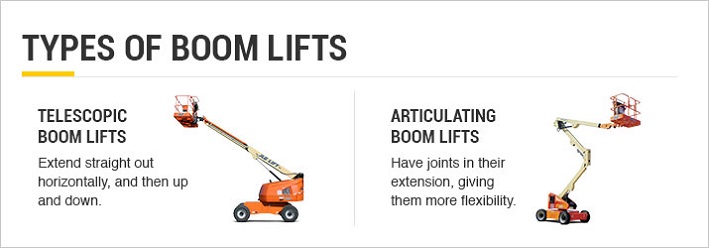
How the platform moves depends on the type of boom lift. Telescopic boom lifts extend straight out horizontally, and then up and down. Articulated boom lifts, on the other hand, have joints in their extension (also known as knuckle lifts), giving them more flexibility.
Wear a harness and secure the lanyard to the bucket.
Since these lifts are not just going straight up in the air, there’s additional risk for the person riding in the platform. Regardless of whether you’re in a telescopic or articulating boom lift, make sure you always wear your harness and securely fasten the lanyard to the platform as instructed in the manufacturer’s manual. Falling out of the platform may seem unlikely, but an unexpected force from a collision with another piece of equipment or a gust of wind could knock you out off of the platform; without a harness and lanyard, it could result in serious injury or death.
Do not use a boom lift to lift heavy supplies.
Boom lifts are meant to lift people and tools to reach a certain area to work. They are not meant to lift heavy supplies — if you need to lift heavy supplies, you need to use a crane. Trying to use a boom lift to raise heavy supplies off the ground could result in tipping the lift over or something worse — putting those using the lift and those in the area at risk for injury or death. Know the capacity requirements and the acceptable uses and stick to them.

Do not climb or sit on the edge of the work platform.
While the platform sizes may differ between a scissor lift and a boom lift— the rules are much the same. Never climb or sit on the edge of the platform. If you are having trouble getting to an area that is out of reach, work with the boom lift operator to get into the position you need. Do not under any circumstances try to reach by climbing on the edge of the platform.
Clear people from the base and entire circumference of the boom lift.
Since boom lifts’ range of motion is greater than a scissor lift, it affects a larger area on site. Workers should avoid not only the base of the boom lift, but also the entire circumference of the boom lift, which can be a wide area. This may seem like an excessive measure to take, but tools or other pieces of equipment can be accidentally dropped from the basket and result in an injury to someone on the ground. In rare cases, boom lifts can tip over, much like scissor lifts, but with a greater reach, the boom lift could cause catastrophic damage. To be safe, make sure the area is completely clear.
Follow manufacturing instructions for moving around the job site.
When moving the boom lift around the job site, make sure you know whether it can be moved in an upright position. If it is not meant to be in motion while it is extended, do not try to move it. And even if it is permitted to move while fully extended, avoid it if possible. Navigating around a job site with a boom lift fully extended puts the person in the work platform at risk, and also puts the operator at risk for bumping into other pieces of equipment, structures or even electrical wires. With or without someone in the bucket, you have an increased risk of an accident, so we recommend keeping the bucket down when navigating around the job site.
Electric Boom Safety Inspection Checklist
Electric boom lifts are ideal for confined and side-to-side workspaces. Because these aerial lifts can hold different attachments, safety risks can increase. The following safety tips can help protect you, your employees and electric boom lift from hazardous situations:
- Prior to use, electric boom lifts should be given a warm-up period. Test the lift’s hydraulic system and lift control before operating. You should report and fix any malfunctions or unsafe conditions.
- Never overload the lift’s load capacity. Because electric boom lifts can only hold one person at a time, overloading it with people or tools can cause complications.
- Secure all equipment on the inside of the boom lift. Electric boom lifts are often used for tight spaces and electrical work, so securing all equipment is essential. If anything snags on surrounding areas, it can harm you and damage other objects.
- Give special attention to direction of travel, clearances above, below and on all sides of an electric boom lift. Confined spaces create the potential for more hazards and unsafe situations. Make sure the areas of operation are clear of clutter to allow for easy access of the boom lift.
Straight Telescopic Boom Safety Inspection Checklist
The straight telescopic boom rental is one of the safest lifts on the market to use and operate. The boom, rotating cab and wheels are the only moving parts, so there are fewer parts to be cautious of. All lifts should still be inspected before usage. Make sure to assess the following:
- Double-check the tires before renting a straight telescopic boom lift. Before each use, ensure all tires are in good condition and inflated to match the specifications listed on the exterior tire wall. This ensures proper load balancing as well as fuel efficiency in gas-powered, self-propelled models.
- Verify the fluid levels of all systems within the engine and the lift components of the unit. Repair any leaks immediately and before use. Verify the condition of the vehicle’s battery and any charging units.
- Limit your use of the telescopic boom lift to areas that are clear of tall or overhead hazards. The lift’s inability to reach around such obstacles can be limiting and even dangerous in some environments.
- Inspect the telescoping boom of the lift for any dents, rust or damage. If present, correct these issues before regular usage.
- Never exceed the platform or bucket’s maximum weight capacity. Make sure to factor in the weight of all workers, tools and materials for an accurate total.
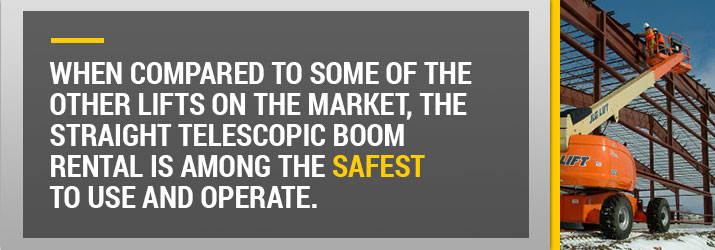
Articulated Knuckle Boom Lift Safety Inspection Checklist
The presence of additional moving parts, such as the knuckle itself, makes the inspection process more complex for a knuckle boom lift. These points should be covered before you rent a knuckle lift and before each use:
- Pay extra attention to your working environment, especially when outdoors. Winds over 25 MPH can tip or damage the lift. Additional caution is advised for the articulated knuckle boom, due to its extended reach and knuckle mechanism.
- Ensure safety features are intact. Make sure guardrails are properly installed and are free of any rust, dents or damage. Close any access gates before lifting the platform.
- Verify the position of any outriggers before operating the lift. When moving or repositioning, make sure the outriggers are in the stowed position. Outriggers should always be used when a worker is in the basket and extended to any height.
- Take the time to inspect the boom fully before each use, especially the knuckle itself. Any visible damage or rust should be repaired immediately and before use.
- Articulated knuckle lifts should only be used by a certified professional. The sheer size and scale of these lifts make them incredibly dangerous when operated by an inexperienced person.
Towable Boom Lift Safety Inspection Checklist
Safety inspections are not only required for the towable boom aerial lift, but also for the towing aspect of these machines. Refer to the following guidelines to ensure your safety:
- Make sure entrance gate and openings are closed. It’s imperative that the gate and other openings are closed to secure the operator and tools.
- Use a body harness or a retaining belt. If you are not fastened to the towable boom lift, the potential of falling increases. Be sure you are safely attached to the aerial lift.
- Always place the lift on solid ground. If the towable boom lift is placed on uneven or sloping ground, the lift can easily tip if its weight is off-center.
- Use appropriate towing equipment. If your towable boom lift is not correctly hitched to a vehicle, it can become unattached. In this instance, the lift has potential to harm other drivers and bystanders.
Personnel Lift Safety Tips
Be sure to go over important inspection points before you use, buy or rent a personnel lift. These tips can ensure the safety of your employees and the reliability of your equipment over time. Consider the following safety points before using your personnel lift:
- Personnel lifts should only be operated by trained and qualified workers. Failure to abide by this rule could result in a voided warranty or personal liability on your behalf.
- Never modify a personnel lift. This is especially true when you rent a personnel lift from a third party. An exception can be made for modifications and upgrades that are certified or produced by the lift’s manufacturer, but only if you own the lift.
- Workers should never ride on the platform of the lift while it is in motion. If adjustments need to be made to its position, all occupants should exit the lift and remain clear until it has been moved.
- Utilize the lift’s outriggers and wheel chocks to provide additional stability. This is especially helpful when working on an incline, as these tools can be used to level the lift.
- Designate responsibilities in the lift. If two workers are on an elevated platform at the same time, one should be designated to operate the controls. This prevents confusion and maximizes efficiency and safety.
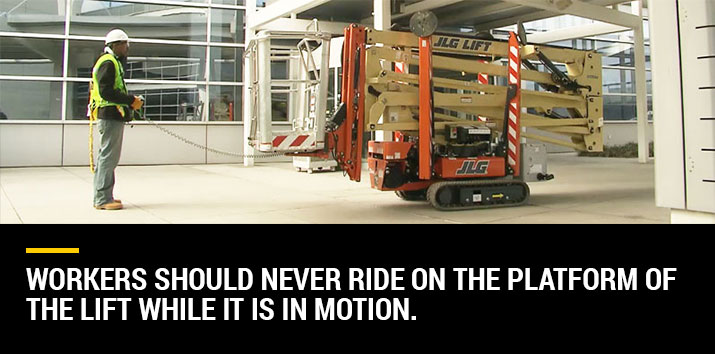
Atrium Lift Safety Tips
If you want to buy or rent an atrium lift, it’s important that you’re up-to-date on the potential dangers, safety mechanisms and emergency response procedures. This information will keep your lift running over time and could even save a life. Take note of these important details:
- Safety guardrails should be fully intact around the work platform. These should be free of any rust and clear of any visible damage or erosion. Replace any worn or damaged sections immediately and before further use.
- Double-check the condition of the lift’s components and track. Make sure to include any stabilizers or outriggers, as they are critical to maintaining the lift’s balance during normal usage.
- Be aware of any overhead obstacles or potential hazards. Hidden dangers may not be visible from the ground level — stay alert for possible issues as the lift moves upward.
- Look out for excess rust, dirt or grease on any articulated joints. If rust cannot be removed, it might be time for a replacement or repair.
- Verify the operability of control panels on the base and in the lift. Technical failures are typically a simple and affordable repair, but they can cause serious setbacks if left not identified before starting a job.
- Check the fluid levels of the lift’s engine and hydraulic system. The hydraulic system is responsible for moving the boom, so it’s essential that these hoses and tanks are free of any damage or erosion.
Implement your own additional rules and guidelines for using atrium lifts on your jobsites. You can never be too safe! At MacAllister Rentals, we offer aerial lift safety resources. You can also check with local college campuses in your area for information on classes or training sessions they offer.
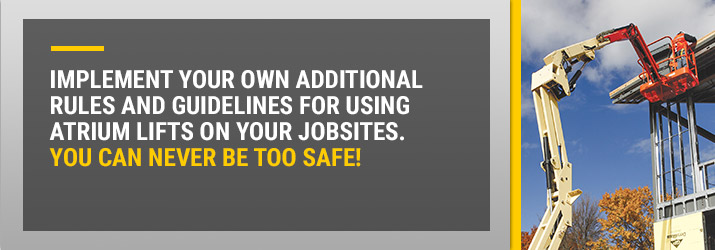
For further safety education and instruction, you may want to consider signing up for safety training at MacAllister Rentals or enrolling in a class at a local university.
Aerial Lift Rentals
Another part of aerial lift safety is the maintenance of the machine. Just like a car or truck, they need to be inspected and taken care of — without regular maintenance, over time they can be more likely to malfunction and break, putting users and others at risk. If you own, or are interested in purchasing an aerial lift, this is something to keep in mind. While maintenance can be expensive, it is an investment that needs to be made for the sake of your employees. If maintenance proves to be too expensive for you, or you are considering renting an aerial lift, you need to make sure the company you rent from has kept up with the maintenance on their models.
At MacAllister Machinery, we make the maintenance and care of all of our rental equipment a priority. We carry a variety of aerial lifts, including: atrium lifts, electric scissor lifts, electric boom lifts, personnel lifts, rough terrain scissor lifts, straight telescopic booms, articulated knuckle booms and towable boom lifts. Our aerial lifts are Genie and JLG — two brands known for their high quality, versatile equipment. We offer a wide range of options in Michigan and Indiana. Learn more about the aerial lift rentals we offer, or call us at (877) 700-1945 to get a quote on a piece of equipment today.
